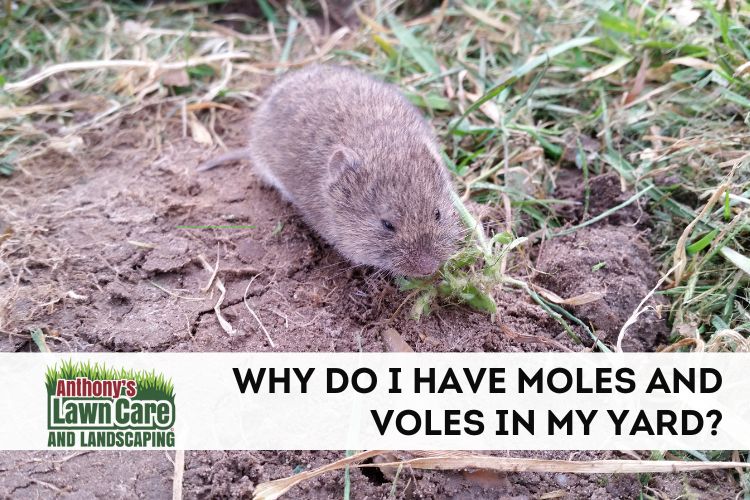There it is! In your garden you are spying a small brown or gray furry creature scurrying around and the questions start. Is that a mole or a vole? Why is it here? And most importantly, is it going to hurt my garden, landscape, or home?
Here in Indiana, moles and voles often find their way into our properties but their effect can be roughly the same. They are here for different reasons, will consume different things, and ultimately both can be seen as a foe rather than a friend. The first thing to do is try and get a look at their bodies and the burrows they’ve created to know whether we are looking at a mole or vole, and from there, it is important to call a lawn care company experienced with preventative measures that will help to safely and humanely redirect their attention away from your lawn.
What is it?
When identifying these creatures, it’s easiest to look at two factors, their feet, and the holes and tunnels they make in your lawn. Although both moles and voles are mammals, moles are technically in the shrew family while voles are rodents. They’re both relatively small, have similar brown or gray fur and pointy snouts. A vole resembles a mouse and tends to spend more time above ground or in shallow tunnels. A mole is a little larger, has shinier fur, and digs deeper tunnels. But their feet are the big give-away. Voles have small delicate feet, while moles have larger paddle shaped feet, which they use for digging. And finally, the entrances to their tunnels will seal the deal as to what you have in your yard. A cone-like, volcano shaped dirt pile at the entrance of the tunnels means it’s a mole. A smaller flatter hole means it’s a vole.
Why are they here?
Both moles and voles have shown up because they want food. But which food they want is totally different, and whoever your visitors are, you’ll need to get rid of them. Moles may have the more irritating tunnels and tend to create networks of them under your feet. They’re only digging to find more grubs, insects, and worms, but that doesn’t mean that they’re not harmless to your garden. Even one mole in your garden can disrupt the balance because of the sheer quantity of food they need to survive. In the end, they can be extremely destructive.
In contrast, voles are consumers of everything plant-like; tree bark, roots, vegetable crops, bulbs, shrubs, and even lawns. The effect of a mole on the health of your garden may take time because the destruction of plants is a side effect of their efforts to find more insects and bugs. But the effect of a vole can be seen quickly. They’ll consume every root system they can find and things will start to die quickly.
How can I stop moles and voles?
The first thing to do is establish preventative measures to dissuade moles and voles from making their homes in your yard or garden. Although some of these you can do on your own, others would be better handled by a lawn care specialist.
- Clean up: Moles and voles love brush, weeds, unkempt grass, and wild vegetation. By removing excess mulch, mowing grass, gathering fallen branches and twigs, tidying up bird feeders and the fallen seeds (which voles love to eat), and pulling weeds, you are helping to take away the welcome mat.
- Protect your plants: Especially with the root-munching voles, creating barriers around gardens, plants, trees, and shrubs can be essential to dissuading them. Mesh guards made of ¼ inch hardware cloth are typically best to “cage” the roots and surround the garden itself, always about 10 inches deep. I would definitely recommend a lawn care professional to help with this project.
- Protective plants: Believe it or not, some plants are known to repel moles and voles. Ask your lawn specialist about making a “fence” of marigolds, garlic, daffodils, shallot, or alliums to name a few.
- Dry it up a little: Excess water makes for soft dirt, which is easy to dig through. Don’t overwater, and consider adding more dirt to areas that collect rain water to counteract the pooling effect.
- Gravel: Adding gravel to your bulb holes will help to deter voles from chowing down.
- Step on it!: It may sound mean, but repeatedly stepping on the tunnels to collapse them can help to shoo away moles.
While moles and voles can appear to come to your yard out of nowhere, they’re really just looking for food. And they have no idea that they’re about to ruin your hard work in the process. Repellents, ultrasonic devices, and rodenticides can have huge adverse effects on your lawn and other more welcomed creatures, not to mention that they often aren’t effective. The best idea is to call lawn care specialists, like Anthony’s Lawn Care, who will know safe and creative ways to use your yard against the invaders. Call (812) 345 – 5694 to get started with your plan.


Recent Comments